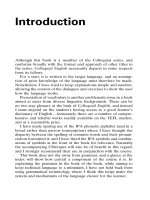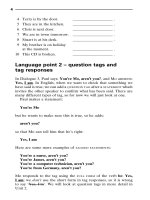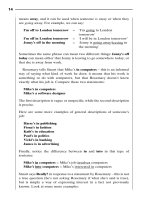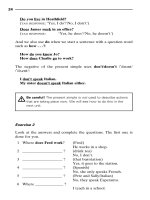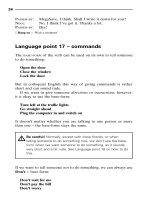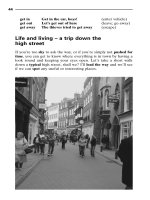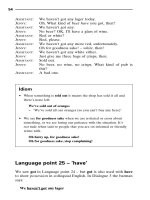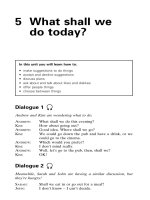Tài liệu A complete English language course part 19 doc
Bạn đang xem bản rút gọn của tài liệu. Xem và tải ngay bản đầy đủ của tài liệu tại đây (102.65 KB, 10 trang )
Quite has two different meanings. When Helen says:
These are all quite nice
she means that they are ‘medium-nice’ – not very nice, but nice
enough. But when she then asks the shop assistant:
Are you quite sure?
she means ‘Are you completely
sure?’.
quite = [medium degree]
quite = completely
But not quite always means ‘not completely’:
I’m not quite
sure where to go
The food isn’t quite
ready
I’m not quite
convinced that this is the right thing to do
You will come across other
DEGREE WORD
s in colloquial English.
Here they are in approximate order:
High degree: completely quite absolutely
(= completely)
extremely
really awfully terribly
very
Medium degree: pretty
quite fairly
164
Be careful! We can use a and the before very, but not before
quite and too:
This shirt is small – it’s a small
shirt
This shirt is very small – it’s a very
small shirt
This shirt is quite small – ‘it’s a quite small shirt
’
(but we can say – it’s quite a
small shirt)
This shirt is too small – ‘it’s a too small shirt
’
ƽ
Medium to low rather (usually with bad or
degree: negative meanings)
Low degree: not very
a bit
slightly
Here are some examples of these:
This book is really boring
John’s absolutely certain he left his wallet on the table
I’m fairly sure that’s our bus
This film is pretty good, isn’t it? – Yes, it’s quite entertaining
This house is rather ugly
This food’s not very nice, is it?
My watch is slightly slow
I felt a bit sick on the way home after the party
Exercise 4
In Jim & Kate’s Coffee Shop they only sell one type of coffee, but
at different temperatures. Can you put them in order, starting with
the coldest and finishing with the hottest? Here’s the menu.
1111
2
3
4
5
6
7
8
9
10
11
1211
13
14
15
16
17
18
19
20
21
22
23
24
25
26
27
28
29
30
31
32
33
34
35
36
37
38
39
40
41
4211
165
Froth Fantasy
quite hot
Coffee Crikey
very hot
Bean Bonanza
not very hot
Radical Roast
extremely hot
Gorgeous Grind
not hot at all
Percolator II
too hot
Cafetiere Combo
rather hot
Steam Surprise
terribly hot
Language point 63 – ‘some’ and ‘one’
Some (and any) can be used with both
UNCOUNTABLE
nouns and
PLURAL COUNTABLE
nouns – review Language point 23 in Unit 4 if
you need to remind yourself of these.
UNCOUNTABLE
Have you got any money?
– Yes, I think I’ve got some
in my pocket
PLURAL COUNTABLE
Have you got any pens?
– Yes, I think I’ve got some
in my desk
You can see from these examples that we can use them to avoid
repeating a noun that has already been mentioned. More examples:
UNCOUNTABLE
We’ve run out of milk!
– It’s OK, I’ll get some
when I’m out
PLURAL COUNTABLE
Will we need sandwiches?
– Yes, I’ll bring some
tomorrow
UNCOUNTABLE
Do you like Christmas pudding?
– I don’t know. I’d better try some
PLURAL COUNTABLE
I can’t find any
biscuits
– I think there are some
in the cupboard
With
SINGULAR COUNTABLE
nouns we use one, not some:
I want a biscuit! – I think there’s one
in the cupboard
Would you like a
sandwich? – Yes, have you got one
?
And we also use one with
ADJECTIVES
to take the place of a noun.
Helen and the shop assistant are talking about tops; the assistant
says:
That green one
really suits you
and Helen asks:
Better than the blue one
?
When we use a, the, this, that, these or those +
ADJECTIVE
but without
the noun, we have to use one (singular) or ones (plural) instead:
166
this blue shirt this blue one
not ‘this blue
’
a green shirt a green one
not ‘a green’
blue shirts blue ones
not ‘blue
’, not ‘blues’
these red shirts these red ones
not ‘these red
’, not ‘these reds’
Exercise 5
Answer these questions using the adjectives given. You’ll have to
decide whether to use one or ones. You may also need to add the.
1 Do you want the red tie or the blue tie?
I want the blue one. (blue)
2 Which knife shall we use for this?
Let’s ____________ . (long)
3 Which bananas would you like?
_________________ . (ripe)
4 Which car is yours?
_________________ . (big red)
5 Shall I wear the brown shoes or the black shoes?
Why don’t you_________________ ? (black)
6 What size drink would you like with your meal?
_________________ . (large)
7 What kind of lenses have you got?
_________________ . (plastic)
8 Do you want a hot drink or a cold drink?
_________________ . (hot)
1111
2
3
4
5
6
7
8
9
10
11
1211
13
14
15
16
17
18
19
20
21
22
23
24
25
26
27
28
29
30
31
32
33
34
35
36
37
38
39
40
41
4211
167
Be careful! We use ones, not some, after adjectives:
those red ones not ‘those red some
’
But we can use some before adjectives:
some red ones not ‘some red some
’
ƽ
Exercise 6
Complete this conversation between Keith and Carl with one or
ones.
C
ARL
: Hello, Keith. I like your motorbike. I’d like to get
(1) _____ like that myself.
K
EITH
: That’s not all – I’ve got another (2) ____ in the garage.
Do you like my boots?
C
ARL
: Well, I think leather (3) ____ suit you better, like the
(4) ____ I’m wearing.
K
EITH
: Where did you buy them?
C
ARL
: In a shop on the High Street – the (5) ____ next to the
music shop.
K
EITH
: Oh, I know. It’s called ‘Boots & Suits’.
C
ARL
: No, that’s the wrong (6) ____ . That (7) ____ is further
down the road. The (8) ____ I mean is called ‘Neat
Feet’.
Dialogue 5
Vicki and Leasa have been clubbing.
V
ICKI
: Come one, Leasa – we can get a bus at the end of the
road.
L
EASA
: A bus? Look at the time, Vicki!!
V
ICKI
:[looks with difficulty at her watch]
Midnight – what’s the big deal?
L
EASA
: We’ll never get a bus at this time of night. We’d be
better off phoning for a taxi.
V
ICKI
: A taxi? That’ll cost a small fortune – don’t you
remember where we live?
L
EASA
: Listen Vicki, we can split the fare and at least we’ll
get home in one piece. Now phone, will you?
V
ICKI
: All right, all right . . .
[phones on her mobile]
. . . I didn’t feel like waiting for a bus anyway.
168

